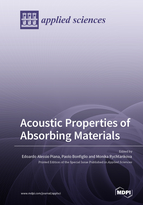Acoustic Properties of Absorbing Materials
A special issue of Applied Sciences (ISSN 2076-3417). This special issue belongs to the section "Acoustics and Vibrations".
Deadline for manuscript submissions: closed (30 September 2021) | Viewed by 32160
Special Issue Editors
Interests: vibro-acoustics; environmental noise control; room and building acoustics; experimental methods and in-field measurements; properties of conventional and unconventional acoustic materials
Interests: porous material vibro-acoustic characterization and design; numerical modeling for the study of acoustical radiation and noise control; active noise control
Special Issues, Collections and Topics in MDPI journals
2. Faculty of Civil Engineering, Slovak University of Technology in Bratislava, 810 05 Bratislava, Slovakia
Interests: building and room acoustics; environmental acoustics; virtual acoustics; perception of sound
Special Issues, Collections and Topics in MDPI journals
Special Issue Information
Dear Colleagues,
A wide range of sound-absorbing elements are currently available to adjust the acoustic features of an environment, thanks to the progress made in materials research and to the introduction of innovative manufacturing technologies. Nowadays, performance is only one of the required specifications, together with environmental compatibility, longevity, and affordable cost.
“Acoustic Properties of Modern Sound-Absorbing Materials” will collect the most recent advances in the broad-spectrum characterization of sound-absorbing materials used in civil, industrial, and tertiary applications by means of experimental, numerical, or theoretical studies. Works related to the development of novel materials and meta-materials are also welcome.
Dr. Edoardo Piana
Dr. Paolo Bonfiglio
Prof. Dr. Monika Rychtarikova
Guest Editors
Manuscript Submission Information
Manuscripts should be submitted online at www.mdpi.com by registering and logging in to this website. Once you are registered, click here to go to the submission form. Manuscripts can be submitted until the deadline. All submissions that pass pre-check are peer-reviewed. Accepted papers will be published continuously in the journal (as soon as accepted) and will be listed together on the special issue website. Research articles, review articles as well as short communications are invited. For planned papers, a title and short abstract (about 100 words) can be sent to the Editorial Office for announcement on this website.
Submitted manuscripts should not have been published previously, nor be under consideration for publication elsewhere (except conference proceedings papers). All manuscripts are thoroughly refereed through a single-blind peer-review process. A guide for authors and other relevant information for submission of manuscripts is available on the Instructions for Authors page. Applied Sciences is an international peer-reviewed open access semimonthly journal published by MDPI.
Please visit the Instructions for Authors page before submitting a manuscript. The Article Processing Charge (APC) for publication in this open access journal is 2400 CHF (Swiss Francs). Submitted papers should be well formatted and use good English. Authors may use MDPI's English editing service prior to publication or during author revisions.
Keywords
- Sound absorption
- surface acoustic properties
- metamaterial
- porous material
- environmental compatibility
- life cycle assessment
- experiment
- simulation
- model








